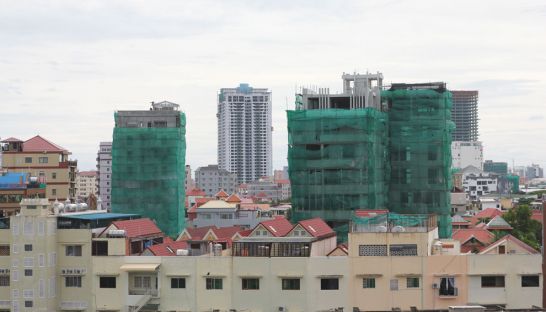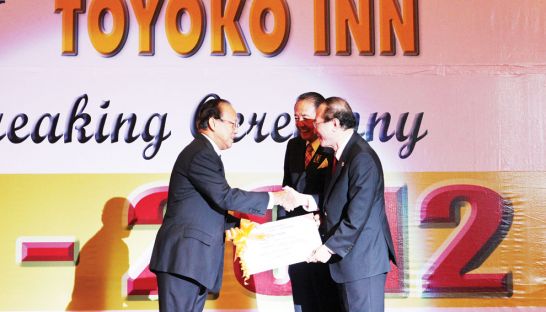Bon voyage or deja vu?
Bon voyage or deja vu?
It’s 60 years since the French were dominating Phnom Penh’s architecture, so should we now be battling to save it, or other parts of our country’s heritage?
As Cambodia on Saturday celebrates the 60th anniversary of independence from France, the Phnom Penh property market is still in a quandary about how much colonial architectural heritage should be preserved.
Many historic buildings have already gone, some are on the brink of survival, while others, restored close to their former glory, are testament to how the city earned its reputation of once being the Pearl of Asia.
Just how much French architectural heritage should be saved and at what cost has become a contentious issue. The legacy constitutes part of Phnom Penh’s identity, but some believe the New Khmer Architecture is more vulnerable than its European predecessor. Others believe in development at all cost.
Andeol Cadin, a French architect resident in Phnom Penh for nine years, said this week the preservation of French colonial architecture was a culturally sensitive issue.
He was reiterating the thoughts of others earlier this year, notably fellow architect and Khmer Architecture Tours guide Yam Sokly and Royal University of Phnom Penh linguistic professor Jean-Michel Fillippi.
Whereas the preservation of any noteworthy architecture was in itself worthwhile, Cadin said there were many competing interests in Cambodia that had to be balanced and many perspectives taken into account.
“We all like to see historic buildings preserved, but you have to see it in a cultural context,” he said. “For instance, although there are still many French colonial buildings preserved in Phnom Penh, and many that still could be, the number of outstanding examples of the New Khmer Architecture is rapidly declining,” he said.
“It is quite possible that within a few years there may be none left at all.
“The New Khmer Architecture movement is globally recognised – that’s how important it is. So no one could blame people concerned about Cambodian culture to be putting more effort into rescuing those examples. Perhaps that’s where the focus and efforts should be.”
Yam Sokly said this week there had been a few more demolitions of French colonial architecture since the start of year, but that so far he wasn’t aware of any further buildings being restored.
Sokly said the famous colonial police commissariat (on the corner of Street 13 and 98 and pictured on the front page) did not appear to be deteriorating any more rapidly than before.
“It is slightly damaged and deteriorated. But off course, with proper maintenance every building will be slowly deteriorating,” he said. “It will be quite a long time before that building is no longer able be rescued. Because the building’s structure is super strong. So far, no serious cracks have appeared on the walls.
Sokly said he still held out hopes for Postal Square becoming a protected heritage zone.
“There has been lots of discussion on that issue. Off course, Town Hall has is planning something and the Ministry of Culture and Fine Arts is working to propose it as a protected area in the future.
“There is a semi-formal registration (of historic buildings) by the municipality and the government of Cambodia. That registration includes the date of the location, date of construction, style of the building, a short description of the master plan of the building, and some other information too.”
Sokly’s business, Khmer Architecture Tours, will be holding a cyclo tour of historic Phnom Penh sites next Sunday (email [email protected]).
Sokly said at the start of the year that the city’s urban design philosophy stood at a crossroad: it could become Paris, where old buildings spanning back centuries have been well preserved; or New York, where urban preservation failed to take hold in time to save much of its architectural heritage.
Fillippi, who wrote the book Strolling Around Phnom Penh, said in January: “You can’t protect at any cost, that’s impossible.”
“You should find solutions of compromise here and there that will still preserve the appearance of a building,” he said.
While the appearance of an old building may be preserved, its function may have to be dramatically overhauled for the needs of a modern society.
“You should find solutions of compromise here and there that will still preserve the appearance of a building.”
Filippi suggests that a similar solution be found for the commissariat.
“You could destroy the interior but keep the façade,” he says. “I think that such compromises will be the rule in the coming years.”
Filippi believes the overall prognosis for Cambodia’s French cultural heritage is positive.
“I don’t think that the French heritage is endangered in any sense.
“We have enough French buildings here, comparatively much more than in Saigon.”
However, he believes the New Khmer Architecture is more vulnerable than the French, due to the former’s emphasis on external space.
“In the ’60s, space was an essential notion of architecture. Not only the building itself, but what surrounded the building was absolutely essential. And of course, that space which was part of that architectural composition is threatened because they now build everything they can around it.”
Such was the case with Vann Molyvann’s Olympic Stadium, which originally contained a series of pools surrounding the complex that were designed to absorb flood waters during the rainy season.
However, that area was filled in with new structures when a Taiwanese firm developed the area in 2000. In addition to harming Vann Molyvann’s architectural vision, the modification has increased incidences of flooding in the area.
“It is a very dubious conception,” Filippi says.
Such intentional functionality was an integral part of the New Khmer Architecture movement which, according to Fillippi, was unique in the region for its combination of brilliant aesthetics and striking practicality.
“I think it is one of the most original types of architecture. Cambodia was the only country in the ‘60s to have this modern, functional architecture in Southeast Asia.”
phnompenh post















